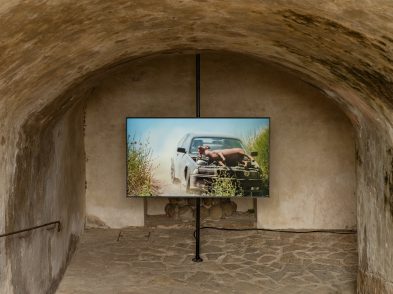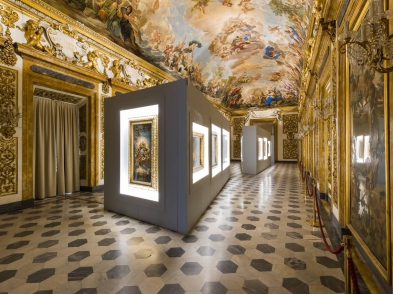Lawrence Weiner, one of the most influential figures in conceptual art,
has created a temporary installation in Florence, his debut exhibition in the
city. The American artist, who in recent years has received a major
retrospective at New York’s Whitney Museum and shown in Toronto, Los Angeles,
Dusseldorf, Paris and London, arrived from Naples, where his latest exhibition
features four new projects.
He immediately set about transforming the compact space of BASE in via
San Niccolò. Appropriately in a city world famous for its frescoes, Weiner
worked straight onto the gallery’s whitewashed walls. And there the direct
comparison with history almost ends.
In the mid-1960s, art in America and Europe took a dramatic step away
from aesthetic traditions that dated back at least to the Renaissance. Weiner
was at the forefront of this development. The image-as a painting or
sculpture-was supplanted as the dominant means with which artists expressed
their view of the culture around them by the idea, and that idea was often
conveyed in words instead of marks and gestures.
Although it was not new to insert words into an artwork-Picasso, the
Constructivists and the Surrealists had already done that-the radical move by
Weiner and his contemporaries was to replace images with language. ‘Art is of
the moment,’ he insists, and his work represents a profound rethinking of the
relationship between the artist, whom he calls the producer, and the viewer
(‘the receiver’ in his terms).
Weiner makes them equals; the artwork cannot exist without both. And his
materials are not oil paint or stone but language, the means of communication
between people that flourishes in a wealth of interpretations. After all, words
acquire meaning according to their context. Reading becomes a performance,
sweeping the artwork into action within the mind of the viewer.
Moreover, unlike paintings that are limited by their edges, words make
possible an infinite image, always extending its significance depending on
where it is seen and by whom. Words convey ideas beyond the scope of imagery
and, as print, can be distributed in a gallery or book, in a film or recording,
as part of a performance or website. Financial value is not a factor in their
reception.
Thus the material of the artwork is placed equally in the hands of the
artist and the audience to make something with it. As at BASE, words may form
patterns and have colours, but they are unobtrusive and helpful, in the manner
of maps.
Although nothing has been constructed (the artist forbids this), Weiner
regards his text pieces as sculptures. They are objects that take shape in the
mind, intriguing conceptual structures. In Florence, Weiner uses the phrase ‘Ever
So Much.’ Enigmatic in appearance, the statement is echoed in its Italian
transliteration ‘Mai Così Tanto,’ and both lines are spelled out in vinyl
capitals affixed to the wall.
The typeface he customarily uses has been carefully chosen to be as neutral
as possible. Even fonts have cultural associations; with its numerous classical
monuments, Italy knows that better than most countries.
Instead, Weiner seeks to erase the artist’s usual position of authority.
Indeed, the artist does not have to be present to install these words. A
sign-writer or technician can do it as long as instructions about placement are
followed. Where the words appear in a space is important: no two locations are
the same.
Fortunately for Florence, the 70-year-old New Yorker oversaw the
installation himself. Accompanying the inscriptions are two designs in blue and
orange. Neither is easily decoded, reminding the viewer that meaning emerges
from careful attention.
In one, coloured blocks alternate with ampersands and punctuation to
invite thoughts towards a saying, perhaps, or a calculation. In the second room
are two leaping arcs that suggest trails of shooting stars with logo-like
simplicity, but they are as mysterious as the function of the universe they
imply.
Weiner’s proposition takes hold of this space. Its spartan rigidity, as
utilitarian as wharf-side signage, allows not an inch of possibility to be
wasted.
Lawrence Weiner
EVER SO MUCH/MAI COSI’ TANTO
Until April 20, 2012
BASE/Progetti per l’Arte
via San Niccolò 18r, Florence
Tel. (+39)328/6927778; www.baseitaly.org
Tuesday to Saturday, 6pm to 8pm, and by appointment






